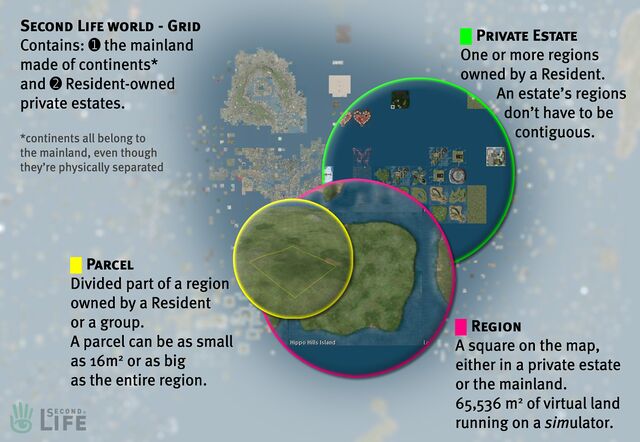Land units
One of the most common confusions about Second Life I (Torley) come across is distinguishing between land hierarchy terms. As in:
- "What's the difference between a region and an estate?"
- "Are a region and a sim the same thing?" (No, not quite; "sim" gets misused often. Learn the difference.)
Totally understandable.
Ever seen the brilliant short, Powers of Ten? I highly recommend watching it, if only to get an awe-inspiring idea of our real world fits together, and how bigger groups contain smaller units.
<videoflash>A2cmlhfdxuY</videoflash>
In a similar way, since Second Life is 3D and graphical, I thought I'd show you an elegant, visual "cheat sheet" of our land hierarchy. Click to enlarge (or right-click and download), and share it with your friends!
In short, the hierarchy, from general biggest to smallest units, is:
- Grid
- Estate
- Region
- Parcel
- Region
- Estate
Important concepts:
- A smaller unit is always contained by a larger unit. Also, a smaller unit can never contain a larger one. For example, regions always belong to an estate. Even if a parcel is the size of a region in an estate consisting of that single region, the parcel still belongs to that region, which in turn belongs to that estate.
- Continents aren't formal units. They're (mostly) contiguous geographical features not systematically represented as such. Their names are also not necessarily shown inworld, but used for cultural familiarity. For example, while Heterocera Atoll is on a different part of the grid than Jeogeot (, they both belong to the same, Linden-administrated mainland estate, as all mainland continents do.
- Square meters (m2) were chosen as a general representation due to their familiarity and rough proportion to avatar size. However, scale is different in Second Life: for example, houses are often more spacious inside due to how the third-person camera controls get obscured by walls. So for practical purposes, virtual square meters aren't the same as real-world square meters.
Obviously, this is a simplified view; Teen Second Life isn't represented, nor are details of various continents and cultural features. If you're interested in more of that,, and we have more information about the above terms.
The above was adapted from this blog post.
See also
- See the Limits page for more numerical information.
